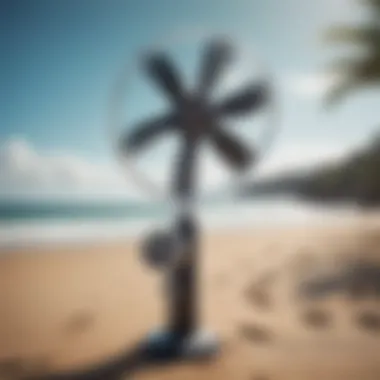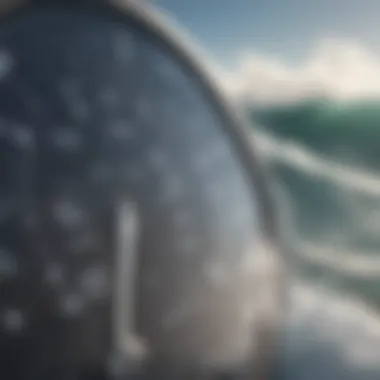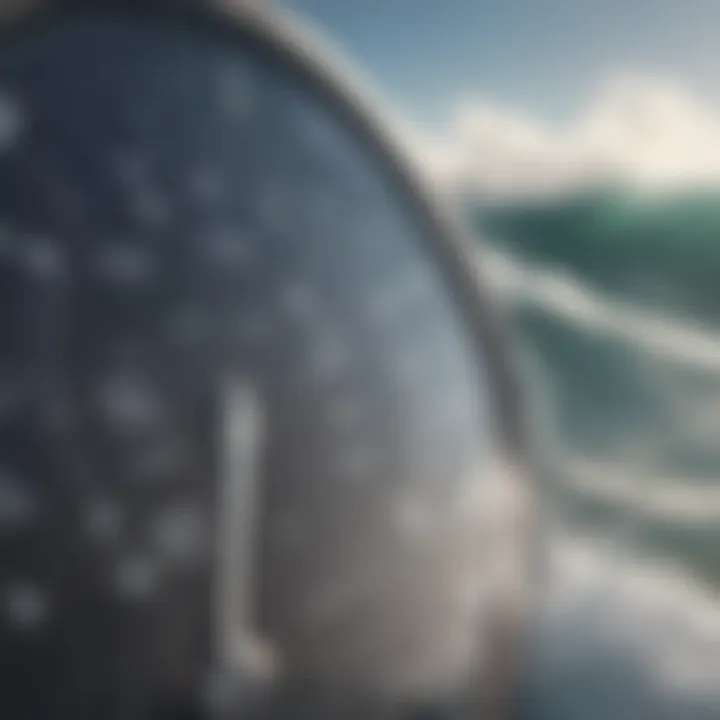Understanding Wind Instruments for Surfing Success


Intro
Understanding the dynamics of wind speed and direction is crucial for anyone who embraces the ocean as their playground. Surfers, seasoned and fresh alike, can greatly benefit from various instruments designed to measure these elements. The right wind conditions can mean the difference between catching that exhilarating wave and missing the ride of a lifetime.
In this discussion, we will unravel the significance of wind speed and direction instruments, paying attention to tools like anemometers, which measure wind speed, and wind vanes, that indicate wind direction. It's not just about having fun in the water; it's about elevating the surfing experience through informed decisions based on reliable data.
Whether you're out there riding the neap tide or just observing from the shore, an accurate understanding of wind data can enhance your safety, performance, and overall enjoyment. Let's delve into the essential techniques and tools surfers use to harness wind dynamics and strive for better surf days.
Surfboarding Techniques
Beginner Tips for Mastering the Basics
For newcomers to surfing, mastering the basics can seem like a mountainous task, but it doesn’t have to be. Finding the right wind conditions is the first step. Here are a few tips to get started:
- Start with small waves: Begin in conditions that are manageable. An unripe wave can be daunting.
- Know the wind: A light onshore wind can help create smaller, more forgiving waves. If the agenda is tackling bigger waves, seek offshore winds that create cleaner faces.
- Practice balance: Spend time on the beach practicing your balance. Transfer that to your board as you paddle out.
By understanding how wind affects wave formation, beginners can make smarter choices about when and where to surf. For example, a beginner may find that they enjoy going out during the early morning, when winds are typically light and conditions calm.
Advanced Techniques for Seasoned Surfers
Once you've graduated from the basics, mastering advanced techniques is the way to elevate your game. Experienced surfers know that wind dynamics can turn the mediocre into the magical. Here are some advanced insights:
- Observe wind patterns: Pay attention to how changing winds affect swell. Watch for shifts in wind direction—these can signal incoming sets of waves.
- Adjust your strategy: Utilize tools like anemometers to measure wind speed precisely. If it’s gusty or offshore, tweak your approach, as these can significantly influence wave quality.
- Timing is key: Understanding tidal patterns combined with wind data can be a surfer’s secret weapon. A swell doesn’t just depend on wind; timing your surf can lead to expertise in peak conditions.
"The best surfers are not just good at riding waves; they understand water's rhythm like a musician gets the beat."
Surfboard Equipment
Reviews of the Latest Surfboards on the Market
Choosing the right surfboard can be as tricky as deciphering a weather report. However, with a bit of research and the right wind information in hand, finding a board that compliments your style becomes easier. Here are some boards currently making waves in the market:
- Firewire Surfboards: Known for their eco-friendly materials and innovative designs. Great for those seeking performance and sustainability.
- Channel Islands: Offers a wide range catering to both shortboard and longboard enthusiasts. Versatile shapes can adapt to changing wind and wave conditions effectively.
- Lost Surfboards: With cutting-edge technology, these boards offer speed and maneuverability that seasoned surfers appreciate.
Essential Gear for Every Surfboarder
Beyond just the board, having the right gear can enhance your surf experience. Essential equipment includes:
- Wetsuits: Particularly vital in cooler climates, they protect against cold water and wind chill.
- Leashes: A reliable leash keeps your board close, which is crucial in windy conditions. It reduces the risk of losing your board during high surf.
- Wax: A necessity for grip, ensuring you stay on your board even as the wind tries to toss you around.
In understanding wind speed and direction instruments, surfers can better prepare themselves to work with—rather than against—the ocean’s ebbs and flows. This guide serves not just as a starting point but also as a reminder that knowledge and practice go hand in hand. With experience and reliable wind data, both novice and expert surfers can optimize their performance and enhance safety out there on the waves.
Prelude to Wind Dynamics
Understanding wind dynamics is crucial for anyone who enjoys the surf. Wind doesn't just rustle the palm trees; it plays a pivotal role in wave formation and, consequently, surfing conditions. By studying how wind speed and direction affects the water, surfers can better predict and choose when to hit the waves. Knowing this can be the difference between catching the perfect ride or struggling against choppy, unsurfable conditions.
The Importance of Wind in Surfing
Wind is one of the main ingredients in the recipe for ideal surfing conditions. For surfers, understanding wind dynamics can enhance their experience significantly.
- Wave Creation: Wind transfers energy to the water, generating waves.
- Wave Texture: The wind can either smoothen the waves or create choppy surfaces, influencing how they break.
- Safety Concerns: Strong or unpredictable winds can introduce hazards. Knowledge about wind patterns can help surfers avoid dangerous conditions.
In essence, surfing isn’t just about finding a good wave but also about reading the ever-changing conditions that the wind creates.
How Wind Affects Wave Formation
Waves are born from the interplay between wind and the ocean's surface. When the wind blows across the water, it sets off ripples that grow into waves. The relationship between wind speed and wave size is critical to surfing.
- Light Winds: Gentle breezes usually don't produce significant waves but can help maintain glassy conditions.
- Moderate Winds: Result in small to medium waves, often ideal for beginner and intermediate surfers.
- Strong Winds: Can generate larger, more powerful waves but may also create irregular, washed-out conditions.
"Waves shaped by wind can either be a surfer's best friend or their worst foe."
Understanding these concepts allows surfers to anticipate the surf conditions better. Moreover, wind direction influences how waves break. For instance, waves that come in at an angle due to crosswinds might not create ideal rides. Surfers need to keep an eye on wind patterns in conjunction with tide charts and swell sizes to grasp the holistic picture.
In summary, wind significantly impacts surfing, from predicting wave formation to ensuring that conditions remain safe for adventurers ready to embrace the water. Understanding this complex relationship not only informs a surfer’s instinct but also safeguards their experience in the vast expanse of the ocean.
Types of Wind Speed Instruments
When it comes to surfing, understanding the winds that grace the ocean is paramount. This is where wind speed instruments come into play. They serve as your eyes and ears in the environment, translating nature’s raw data into usable information. The ability to accurately gauge wind speeds can mean the difference between a thrilling ride or a day spent watching the waves from the shore. Hence, grasping the nuances of different wind speed instruments opens new doors for surfers, whether they’re seasoned pros or just getting their feet wet.
Anemometers Explained


Anemometers act as the frontline heroes in capturing wind speed. These instruments come in several varieties, each with its own merits, catering to distinct needs and preferences of surfers.
Mechanical Anemometers
Mechanical anemometers rely on physical components to measure wind speed. Their key characteristic is simplicity. They usually consist of rotating cups that catch the wind. The faster the wind blows, the quicker the cups spin, allowing for direct readings.
What makes mechanical anemometers a prized choice for many surfers is their durability. They don’t rely on batteries or electronics, making them a reliable companion in rugged environments. However, they aren’t without drawbacks – they can be a bit slow to respond to sudden gusts compared to their digital counterparts.
One unique feature of mechanical anemometers is their ability to work in a variety of conditions, be it salty sea spray or a heavy downpour. They tend to be more affordable too, which can appeal to novice surfers or those on a budget. Although they may not provide real-time data, their straightforward operation can still guide surfers in understanding prevailing conditions.
Digital Anemometers
Digital anemometers represent the cutting edge of wind measuring technology. They offer instant readings displayed on a digital screen, which is easy to read at a glance. This ensures surfers quickly know what they’re facing, crucial when conditions can shift in a heartbeat.
The key characteristic of digital anemometers lies in the granularity of the data they provide. Many models come equipped with features that offer average wind speeds, peak gusts, and sometimes even temperature readings. For surfers looking for precise analytics, digital options can enhance their decision-making.
However, it’s worth noting that digital anemometers may be more sensitive to harsh conditions. Exposure to water can lead to malfunctions or inaccurate readings if they’re not water-resistant. Additionally, their dependency on battery power can be troublesome when out in the wild surf. Still, many adventurers choose digital models for their cutting-edge features and ease of use, especially for planning surfing sessions with exact wind conditions in mind.
Comparing Handheld and Stationary Models
When weighing your options, it’s crucial to consider whether a handheld or stationary model better suits your needs.
- Handheld Models: These are portable, enabling surfers to take them wherever they roam. Ideal for those who frequently change locations, they fit snugly in a backpack or surf bag.
- Stationary Models: In contrast, stationary models are fixed in one location, often installed on a surf spot or coastal area to gather long-term data. For surf schools or surf community hubs, these serve as invaluable resources for collective knowledge.
Both options offer unique advantages. Handheld devices provide flexibility and immediate feedback, while stationary devices contribute long-term data collection, bridging daily surf conditions with broader trends.
Key takeaway: Choosing the right wind speed instrument hinges on individual preferences and specific surfing goals. A good grasp of this technology not only enhances safety but also enriches surfing experiences by maximizing wave riding opportunities.
Understanding Wind Direction Instruments
Understanding wind direction instruments is far from a mere technical nicety in surfing; it’s something that directly impacts the overall experience of navigating the waves. When surfers catch a swell, knowing from which direction the wind is coming—and how it interacts with the waves—can make the difference between a euphoric ride and a frigid tumble into unforgiving water. The tools used to measure wind direction—like wind vanes and cones—serve practical purposes, helping surfers strategize their surf sessions.
Principles of Wind Vanes
At its core, a wind vane provides a simple yet effective way to determine which way the wind is blowing. The design is intuitive; the rotating arm of the vane aligns itself with the wind, pointing directly toward the wind’s source. This instrument often appears as a fin-like structure mounted atop a pole. The significance of wind vanes in surfing is not just about tracking wind flow, but also understanding how that flow affects wave behavior.
For instance, if you notice that a southwest wind is blowing, it might signal that the waves are getting a clean break. Conversely, a north wind could create chaotic swells, resulting in less than ideal surfing conditions. This knowledge is pivotal for surfers aiming to catch the best waves during their outings. Additionally, wind vanes are relatively low maintenance, providing reliable readings without the need for complex calibration.
In summary, a wind vane isn’t just a decorative piece; it plays a vital role in revealing wind patterns, enhancing the surfers’ capability to make informed decisions about when and where to surf.
Using Wind Cones in Surf Forecasting
Wind cones, or conical wind indicators, function a little differently from wind vanes but are equally important for predicting surf conditions. They usually come in bright colors and have a broad cone shape that catches the wind, showing not only direction but also the intensity of the breeze. The straightforward design allows surfers to quickly glance at the cone and ascertain the current wind situation.
Understanding how to utilize wind cones effectively can sharpen one's surfing strategy. For example:
- Low cones might indicate a light wind, not enough to create challenging waves, making it a good day for beginners.
- Higher cones sway significantly, suggesting gusty conditions that advanced surfers might prefer for challenges like aerial tricks.
Moreover, when combined with other instruments like anemometers (which measure speed), wind cones provide a holistic overview of weather impacts on surf conditions. The synergy between these tools can inform decisions like when to hit the beach, what gear to take, and whether to encourage others to join in the revelry of riding the waves.
The skillful interplay between wind direction and wave formation means that mastery of tools like wind vanes and cones directly translates to surfing success.
Understanding how to interpret these instruments equips surfers and instructors alike with the insights needed for a rewarding session in the water. With clarity on wind patterns, surfers can enhance their capabilities, making every trip to the ocean both pleasurable and productive.
Data Collection and Analysis
Understanding how to collect and analyze wind speed and direction data is critical for surfers and educators alike. This process not only informs surfers about current conditions but also fuels predictions about changes in the surf environment. A diligent approach to data collection can enhance decision-making and performance, allowing surfers to ride the waves more effectively.
Recording Wind Data Effectively
Collecting wind data isn't just about having the right tools; it's about using them accurately and consistently. One of the most effective methods for recording wind data involves using an anemometer at varied intervals throughout the day. Ideally, you want to note measurements at different times, particularly when the winds are shifting or the tides are changing.
Key considerations include:
- Location: Choose spots near your favorite surf breaks, where the readings will be most relevant.
- Time of Day: Wind patterns can vary dramatically between mornings and afternoons; recording these times facilitates better predictions.
- Environmental Factors: Note the presence of nearby structures like buildings or palm trees, which could affect wind flow.
Additionally, using a notebook or a digital app can make logging these readings easier. The use of a mobile app can also streamline this process, as many offer integrated graphs and alerts for real-time wind changes. Collecting data continuously over time allows surfers to recognize patterns, identifying when conditions are ripe for riding.
Interpreting Wind Speed and Direction Data
Once data is collected, the next step involves interpretation. It's not enough just to have numbers; understanding what they mean in relation to surfing is critical. For surfers, wind speed and direction can drastically alter wave conditions.


Isolating meaningful trends is essential. For example:
- Wind Speed: High wind speeds can signify choppy water, while lower speeds often mean smoother waves. The sweet spot for wave riding may vary, but many surfers prefer winds around 10-15 knots for a comfortable ride.
- Wind Direction: An offshore wind typically creates cleaner waves than an onshore wind, which can lead to messy surf.
"Understanding the nuances of wind data can be the difference between a fantastic day on the water and a mediocre one."
To truly glean insights from wind data, setting clear benchmarks based on historical patterns is advisable. Keeping a log of notable days can offer a roadmap for future surf outings. The more experienced surfers tend to develop an intuitive feel for how wind impacts their local breaks, blending personal experience with empirical data.
Utilizing visual aids such as graphs or maps can further enhance understanding. Over time, correlating wind data with surf performance allows surfers to refine their approach to riding the waves. In the end, the goal is not just to record numbers, but to cultivate a deeper connection with the elements, enhancing the overall surfing experience.
Application in Surfing
In the ever-evolving world of surfing, understanding wind dynamics is crucial. It’s not just about catching waves; it’s about riding them with intention and knowledge. Being aware of how wind affects surf conditions can significantly enhance a surfer's experience and safety. Two of the key elements that play a large role are predicting optimal surf conditions and recognizing wind patterns that influence specific surf spots.
Predicting Optimal Surf Conditions
When surfers talk about wind, they often focus on its changing direction and strength. Whether it's the gentle breeze or a strong gale, wind speed and direction can dramatically alter wave quality. Understanding these nuances provides surfers with the ability to forecast the best conditions for their rides.
The interplay between wind and surf conditions can be broken down into several critical factors:
- Wind Direction: It dictates how waves break. For instance, an onshore wind can create choppier waves, making them less favorable for surfing. Conversely, offshore winds can groom the waves, creating cleaner and more manageable face for surfers.
- Wind Speed: This affects wave height and energy. Generally, moderate winds help to build swell, while excessive wind can flatten or disrupt wave formations. Surfers often rely on tools like anemometers to measure these wind speeds and assess their suitability for riding.
- Timing Considerations: Wind can change throughout the day. Surfing early in the morning or later in the afternoon might mean the wind is calmer.
"Monitoring wind conditions not only enhances the experience but also keeps surfers safe - know before you go."
Invaluable resources and tools, such as mobile apps, that provide real-time updates on wind conditions can help surfers make informed decisions. Knowledge of these factors leads to more enjoyable surf sessions and reduces the likelihood of being caught out in suboptimal conditions.
Wind Patterns and Their Influence on Surf Spots
Every surf location has its own characteristics influenced heavily by prevailing wind patterns. Understanding these patterns is essential for anyone looking to maximize their time in the water.
Some aspects to consider include:
- Local Wind Patterns: Each surf spot has its unique behavior when it comes to wind. Some locations might thrive under a specific wind direction, while others may become challenging or unsafe.
- Seasonal Changes: Wind patterns can shift with seasons. For example, summer might bring consistent land breezes that favor certain beaches, while winter might introduce stronger ocean winds that create powerful swells.
- Geography's Role: A surf spot's geographical features can alter wind flow, influencing wave formation. Bays, cliffs, and reefs can all play a part in how the wind interacts with the water, creating distinct surf conditions.
To navigate these elements effectively, surfers often engage in regular observation and analysis of wind patterns in relation to the specific surf spots they frequent. Those who learn to read the wind will find themselves not just riding waves, but genuinely connecting with nature.
By integrating these insights into their routines, surfers can anticipate changes and improve their strategies, ultimately enhancing every surf session.
Technological Advances in Measurement Tools
In the surfing world, where the wind rules the waves, keeping pace with technological innovations in measurement tools is not just useful—it can make or break a session. As surf conditions fluctuate rapidly, having precise data at one’s fingertips can mean the difference between catching that perfect wave or missing out completely. This section looks at modern tools that enhance our understanding of wind dynamics, focusing on smart anemometers and mobile applications.
Smart Anemometers and Their Integration
Smart anemometers are an excellent representation of how technology has modernized wind measurement. Unlike traditional models that provide basic readings, smart versions are equipped with advanced sensors and connectivity options. They can record real-time data on wind speed, direction, and even temperature, making them invaluable for surfers who rely on accurate wind information.
Key Features of Smart Anemometers:
- Real-Time Data Transmission: Most smart anemometers connect via Bluetooth or Wi-Fi, allowing surfers to receive updates directly on their smartphones.
- Integration with Weather Apps: Many of these devices can sync with various weather applications, allowing for comprehensive analysis. This means that you can visualize wind trends alongside swell data, leading to more informed decisions.
- User-Friendly Interfaces: With modern designs, surfers can easily navigate through different readings, historical data, and forecasts in a matter of clicks.
- Durability: Built to withstand tough environmental conditions, these anemometers are often water-resistant and rugged, ideal for the surf zone.
When integrated into a surfer's toolkit, smart anemometers can transform the way surfers approach their sessions. Instead of guessing the conditions, they can rely on precise data to improve safety and performance.
Mobile Apps for Wind Monitoring
In this digital age, mobile applications have rapidly become integral tools for surfing enthusiasts. Apps focused on wind monitoring provide surfers with essential information at their fingertips. They can offer comprehensive forecasts, historical data, and even community-generated reports analyzed by fellow surf aficionados.
Popular Mobile Apps for Wind Monitoring:
- Windy: A favorite among the surfing community, Windy provides detailed wind maps, wave forecasts, and live updates. It stands out for its aesthetic interface and accuracy.
- Surfline: More than just a surf report, Surfline combines detailed wave forecasts with wind conditions, offering live camera feeds from popular surf spots to help surfers find the best conditions.
- Windfinder: This app helps in tracking local wind conditions with its intuitive layout and clear data presentation. It’s particularly useful if you frequent different surf spots.
By utilizing these mobile applications, surfers can engage with wind conditions in real-time. Knowing when to hit the water or when to wait for better conditions has never been easier.
"It’s no longer about just reading the waves; it’s about understanding the wind that shapes them."
With the continual advancement of technology, the ability to monitor wind conditions has become more accessible and accurate. Surfing, which relies so much on understanding environmental factors, stands to benefit significantly from these innovations.
Case Studies
Case studies offer valuable insights into the application and effectiveness of wind speed and direction instruments within the surfing community. By examining real-world instances, we can better understand how these tools influence performance, safety, and overall experiences in the surf. Through detailed comparisons and contextual analyses, one can draw conclusions that may benefit both novice surfers and seasoned instructors alike.
Analyzing Surf Competitions


When it comes to surf competitions, wind conditions can shape the outcome of events in significant ways. Consider the famous Big Wave Awards, where surfers tackle colossal swells. Here, accurate wind speed readings are crucial. For instance, in 2020, certain competition days experienced gusts over 20 knots, which made it challenging for competitors to manage their boards effectively against the ocean. The role of anemometers in such situations cannot be overstated. They help organizers decide if conditions favor a fair competition.
Observing how different surfers adapt to varied wind conditions during competitions gives us a deeper appreciation of their skills. Each athlete forms strategies based on the wind's behavior. For example, when the wind is offshore, it can create clean, peeling waves. The competitors who are adept at interpreting these elements often end up at the top of the leaderboard. Thus, the use of wind direction instruments to analyze patterns can provide a strategic advantage.
Lessons from Experienced Surfers
The experiences of veteran surfers often serve as an invaluable reservoir of knowledge. Many seasoned surfers keep detailed logs of their surf sessions, noting wind conditions alongside wave quality. This anecdotal evidence forms an informal database that emphasizes the necessity of understanding wind dynamics. Experienced surfers frequently identify trends—like how a particular surf spot behaves with an incoming tide and shifting winds.
For instance, a regular at Honolua Bay may notice that while a south wind may produce crisper waves in the summer, a northeast wind often leads to messy conditions. These insights remind upcoming surfers that wind can pivot the quality of their ride dramatically.
Additionally, it is not uncommon to hear surfers discussing their wind predictions before a session. Words like "offshore" and "onshore" float in conversations, revealing an intricate knowledge of how wind impacts their surroundings.
"Wind can make or break your session. Learn to read it; it’s like third eye for surfers." – An Experienced Surfer
These shared lessons foster a culture of continuous learning in the surf community. By pooling their observations and experiences, surfers collectively improve their understanding of how to surf safely and effectively, showing that knowledge passed down through case studies enhances the overall surfing experience.
Safety Considerations
When it comes to surfing, understanding the intricacies of wind dynamics is not just about performance; it is also a matter of safety. Surfing in winds that are either too strong or too weak can create hazardous conditions. This section aims to shed light on the role that wind speed and direction instruments play in ensuring a safer surfing experience.
Understanding Wind Risks While Surfing
Wind poses several risks for surfers. High winds can generate wave conditions that are too challenging, leading to wipeouts, potential injuries, or getting swept away by powerful currents. On the flip side, light winds can signal a lack of decent surf, resulting in surfers being stranded with underwhelming waves.
There are a few key factors to be aware of when assessing wind risks:
- Wind Speed: Strong winds can cause waves to become disorganized and unpredictable, making it difficult to maintain control on your board.
- Wind Direction: Offshore winds, while desirable for wave shape, can be tricky as they may lead to stronger currents pulling surfers away from the shore. Conversely, onshore winds can hamper wave quality and create a choppy surface.
- Local Weather Patterns: Sudden changes in weather can create unexpected conditions on the water. It’s essential to keep an eye on forecasts and remain vigilant.
"A surfer must always respect the elements; ignorance is a recipe for disaster."
These factors underline the importance of having reliable instruments to measure wind conditions effectively. Surfers who harness data from anemometers and wind vanes are better equipped to evaluate their environment, allowing for informed decisions that prioritize safety.
Best Practices for Safe Surfing Conditions
To ensure a safe and enjoyable experience on the waves, surfers should adopt certain practices related to wind conditions. Here are some tips that can help:
- Pre-Surf Checks: Always check local wind reports and forecasts before heading out. Pay attention to both wind speed and direction.
- Use Reliable Instruments: Invest in personal measuring tools such as handheld anemometers. These devices can provide immediate feedback about wind conditions on the spot.
- Know the Surf Spot: Familiarize yourself with how wind affects your favorite surf breaks. Some spots may handle wind better than others, so it’s essential to know where to go based on wind conditions.
- Buddy System: Surf with friends when attempting to navigate challenging wind conditions. It’s safer and makes for better decision-making.
- Always Stay Aware: Conditions can change quickly. Be attentive to the wind and wave patterns while surfing. If conditions become unfavorable, be prepared to exit the water safely.
By following these best practices, surfers can not only protect themselves but also enhance their overall surfing experience, turning potential risks into enjoyable challenges.
Future Trends in Wind Measurement
As we look to the future, the evolution of wind measurement tools is set to have a significant influence on how surfers assess and react to surf conditions. The incorporation of cutting-edge technologies allows for a more refined understanding of wind patterns, ensuring that surfers can better predict the waves they will ride. Wind measurement is not just numbers on a device; it’s about safety, enjoyment, and performance while riding those frothy peaks. In this section, we will explore two key aspects that highlight these future trends:
Emerging technologies and the role of AI in surf forecasting.
Emerging Technologies Impacting Surfing
The surfing world is buzzing with excitement as new technologies emerge, offering more precise and real-time data for surfers. Here are a few noteworthy innovations that are shaping the future of wind measurement:
- Drone-based Anemometers: Drones are taking to the skies with anemometers attached to them, providing surfers with real-time wind speed and direction data from higher altitudes. These tools can analyze larger areas, making it possible to see how local conditions might affect a wave, from currents to wind shifts.
- Wearable Tech: Imagine having a small device on your wrist that tracks wind conditions while you paddle out. Wearable wind meters are becoming a trend. This technology provides surfers immediate feedback on environmental conditions, allowing them to adjust their approach in real time.
- Smartphone Integration: Many modern anemometers can connect to smartphones, integrating various weather data into one app. This connectivity creates a streamlined approach where surfers can analyze conditions right from the surfboard while waiting for the next wave.
The beauty of these advancements is their accessibility. Both seasoned surfers and novices can tune into vital information that was previously restricted to experts or advanced setups.
The Role of AI in Surf Forecasting
Artificial Intelligence is transforming the landscape of surf forecasting. These algorithms analyze vast amounts of data, detecting patterns that humans might overlook. Here are how AI algorithms are reshaping surf predictions:
“AI can forecast conditions at specific surf spots more accurately by analyzing historical climate data, wind patterns, and tide movements,”
Surf technology expert recalls.
- Predictive Analytics: By utilizing complex datasets and machine learning, AI can predict not only wind speeds but also how these factors will change over time. This foresight enables surfers to plan their sessions more effectively, reducing guesswork significantly.
- Customized Forecasts: AI technology can cater forecasts specific to a user’s preferences and habits. For instance, if a surfer prefers stronger winds or certain types of wave breaks, the app can deliver personalized surf notifications, prompting surfers to get in the water when conditions are optimal.
- Community-Driven Data: Platforms can benefit from collaborative efforts where surfers input local conditions. AI can then refine its predictions, making it a community-driven tool, founded on data from those who know the surf spots best.
The convergence of innovative technology and artificial intelligence in wind measurement signifies a promising horizon for surfers. With the right tools at their disposal, surfers across the globe will likely find a new level of engagement and safety in the surf, embracing the waves in a smarter, more informed way.
Finale
In wrapping up this exploration of wind speed and direction instruments in surfing, it is crucial to highlight the transformative role they play in not just enhancing our ride but also ensuring safety out on the waves. Wind dynamics, once understood, become a surfer's best ally. What we’ve seen throughout this article is that comprehending wind velocity and direction isn't merely a technical necessity; it's a way to elevate the surfing experience.
Summarizing the Key Takeaways
- Instruments Matter: Utilizing anemometers and wind vanes can make or break a surf day. They provide critical information that surfers rely on to assess conditions before heading out.
- Safety First: Awareness of wind conditions is paramount. It helps in avoiding hazardous situations, ensuring that both novices and experienced surfers return safely after a session.
- Adapting to Change: Surfers must learn to interpret data correctly, adapting to the ever-changing elements while out on the water. Whether it's that robust offshore breeze whipping up a smooth swell or unpredictable gusts, knowledge is power.
- Tech Trends: With the advent of smart apps and measurement devices, staying informed on wind conditions is more accessible than ever. The integration of technology into surfing offers not only convenience but a wider safety net.
Encouraging Continuous Learning
The world of wind instruments is not static; it evolves. For surfers, instructors, and ocean enthusiasts, continual education about these tools can lead to a more refined capability in reading and reacting to the ocean's whims. Seeking out tutorials, attending workshops, or even following industry leaders on platforms like Reddit or Facebook can provide invaluable insights. As wind patterns shift and technology advances, being proactive in your learning can yield richer experiences on the water.
"In every wave, there is a lesson, and every surfer is a student of the sea."
Surfers are encouraged to cultivate a habit of exploration—dive into scientific studies, engage with online communities, and share knowledge with peers. Embracing the complexity of wind dynamics not only extends the joy of surfing but also fosters a deeper connection with nature. After all, the ocean is an ever-changing tapestry, and staying informed is key to mastering the art of wave riding.















